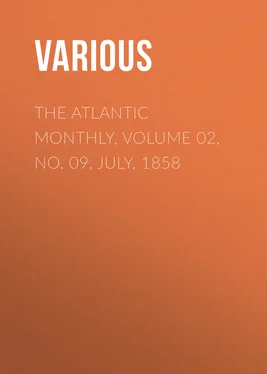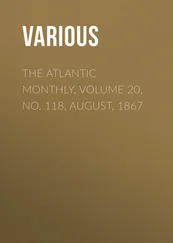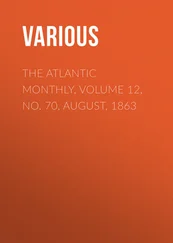Various - The Atlantic Monthly, Volume 02, No. 09, July, 1858
Здесь есть возможность читать онлайн «Various - The Atlantic Monthly, Volume 02, No. 09, July, 1858» — ознакомительный отрывок электронной книги совершенно бесплатно, а после прочтения отрывка купить полную версию. В некоторых случаях можно слушать аудио, скачать через торрент в формате fb2 и присутствует краткое содержание. Жанр: foreign_antique, periodic, foreign_edu, на английском языке. Описание произведения, (предисловие) а так же отзывы посетителей доступны на портале библиотеки ЛибКат.
- Название:The Atlantic Monthly, Volume 02, No. 09, July, 1858
- Автор:
- Жанр:
- Год:неизвестен
- ISBN:нет данных
- Рейтинг книги:5 / 5. Голосов: 1
-
Избранное:Добавить в избранное
- Отзывы:
-
Ваша оценка:
- 100
- 1
- 2
- 3
- 4
- 5
The Atlantic Monthly, Volume 02, No. 09, July, 1858: краткое содержание, описание и аннотация
Предлагаем к чтению аннотацию, описание, краткое содержание или предисловие (зависит от того, что написал сам автор книги «The Atlantic Monthly, Volume 02, No. 09, July, 1858»). Если вы не нашли необходимую информацию о книге — напишите в комментариях, мы постараемся отыскать её.
The Atlantic Monthly, Volume 02, No. 09, July, 1858 — читать онлайн ознакомительный отрывок
Ниже представлен текст книги, разбитый по страницам. Система сохранения места последней прочитанной страницы, позволяет с удобством читать онлайн бесплатно книгу «The Atlantic Monthly, Volume 02, No. 09, July, 1858», без необходимости каждый раз заново искать на чём Вы остановились. Поставьте закладку, и сможете в любой момент перейти на страницу, на которой закончили чтение.
Интервал:
Закладка:
Antonius Discolius her son, and Bibius Felicissimus her foster-child, to Valeria Crestina their mother, a widow for eighteen years. [Her grave is] among the holy. 2 2 This inscription is not of earlier date than the fourth century, as is shown by the words, Inter sancios ,—referring, as we heretofore stated, to the grave being made near that of some person esteemed a saint.
These inscriptions lead us by a natural transition to such as contain some reference to the habits of life or to the domestic occupations and feelings of the early Christians. Unfortunately for the gratification of the desire to learn of these things, this class of inscriptions is far from numerous,—and the common conciseness is rarely, in the first centuries, amplified by details. But here is one that tells a little story in itself:—
DOMNINAE INNOCENTISSINAE ET DVLCISSIMAE COIVGI QVAE VIXIT ANN XVI M. IIII ET FVIT IMARITATA ANN. DVOBVS M. IIII D. VIIII CVM QVA SON LICVIT FVISSE PROPTER CAVSAS PEREGRINATIONIS NISI MENEIE VI QVO TEMPORE VT EGO SENSI ET EXHBVI AMOREM MEVM NVLLI SV ALII SIC DILEXERVNT DEPOSIT XV KAL. IVN.
To Domnina, my most innocent and sweetest wife; who lived sixteen years and four months, and was married two years, four months, and nine days; with whom, on account of my journeys, I was permitted to be only six months; in which time, as I felt, so I showed my love. No others have so loved one another. Placed in the grave the 15th of the Kalends of June.
Who was this husband whose far-off journeys had so separated him from his lately married wife? Who were they who so loved as no others had loved? The tombstone gives only the name of Domnina. But in naming her, and in the expression of her husband's love, it gives evidence, which is confirmed by many other tokens in the catacombs, of the change introduced by Christianity in the position of women, and in the regard paid to them. Marriage was invested with a sanctity which redeemed it from sensuality, and Christianity became the means of uniting man and woman in the bonds of an immortal love.
Here is an inscription which, spite of the rudeness of its style, preserves the pleasant memory of a Roman child:—
ISPIRITO SANTO BONO FLORENTIO QVI VIXIT ANIS XIII QVAM SI FILIVM SVVM ET COTDEVS MATER FILIO BENEMERETI FECERVNT.
To the good and holy spirit Florentius, who lived thirteen years, Coritus, his master, who loved him more than if he were his own son, and Cotdeus, his mother, have made this for her well-deserving son. 3 3 Compare an inscription from a heathen tomb:– C. JVLIVS MAXIMVS ANN. II. M. V.
ATROX O FORTVNA TRVCI QVAE FVNERR GAVDES QVID MIHI TAM SVBITO MAXIMVS ERIPITVR QVI MODO JVCVNDVS GREMIO SVPERESSE SOLEBAT HIC LAPIS TN TVMVLO NVNC JACET ECCE MATER
C. Julius Maximus, Two years, five months old.
Harsh Fortune, that in cruel death finds't joy,
Why is my Maximus thus sudden reft,
So late the pleasant burden of my breast?
Now in the grave this stone lies: lo, his mother!]
And Coritus, his master, and Cotdeus, his mother, might have rejoiced in knowing that their poor, rough tablet would keep the memory of her boy alive for so many centuries; and that long after they had gone to the grave, the good spirit of Florentius should still, through these few words, remain to work good upon the earth.—Note in this inscription (as in many others) the Italianizing of the old Latin,—the ispirito , and the santo ; note also the mother's strange name, reminding one of Puritan appellations,—Cotdeus being the abbreviation of Quod vult Deus , "What God wills." 4 4 Other names of this kind were Deogratias , Habetdeum , and Adeodatus .
Here is an inscription set up by a husband to his wife, Dignitas, who was a woman of great goodness and entire purity of life:—
QUE SINE LESIONE ANIMI MEI VIXI MECVM ANNOS XV FILIOS AVTEM PROCREAVIT VII EX QVIBVS SECV ABET AD DOMINVM IIII
Who, without ever wounding my soul, lived with me for fifteen years, and bore seven children, four of whom she has with her in the Lord.
We have already referred to the inscriptions which bear the name of some officer of the early Church; but there is still another class, which exhibits in clear letters others of the designations and customs familiar to the first Christians. Thus, those who had not yet been baptized and received into the fold, but were being instructed in Christian doctrine for that end, were called catechumens ; those who were recently baptized were called neophytes ; and baptism itself appears sometimes to have been designated by the word illuminatio . Of the use of these names the inscriptions give not infrequent examples. It was the custom also among the Christians to afford support to the poor and to the widows of their body. Thus we read such inscriptions as the following:—
RIGINE VENEMEREMTI FILIA SVA FECIT VENERIGINE MATRI VIDVAE QVE SE DIT VIDVA ANNOS LX ET ECLESA VIXIT ANNOS LXXX MESIS V DIES XXVI
Her daughter Reneregina made this for her well-deserving mother Regina, a widow, who sat a widow sixty years, and never burdened the church, the wife of one husband, who lived eighty years, five months, twenty-six days.
The words of this inscription recall to mind those of St. Paul, in his First Epistle to Timothy, (v. 3-16,) and especially the verse, "If any man or woman that believeth have widows, let them relieve them, and let not the church be charged."
Some of the inscriptions preserve a record of the occupation or trade of the dead, sometimes in words, more often by the representation of the implements of labor. Here, for instance, is one which seems like the advertisement of a surviving partner:—
DE BIANOBA POLLECLA QVE ORDEV BENDET DE BIANOBA
From New Street. Pollecla, who sold barley on New Street.
Others often bear a figure which refers to the name of the deceased, an armoirie parlante as it were, which might be read by those too ignorant to read the letters on the stone. Thus, a lion is scratched on the grave of a man named Leo; a little pig on the grave of the little child Porcella, who had lived not quite four years; on the tomb of Dracontius is a dragon; and by the side of the following charming inscription is found the figure of a ship:—
NABIRA IN PACE ANIMA DULCIS QVI BIXIT ANOS XVI M V ANIMA MELEIEA TITVLV FACTV APARENTES SIGNVM NABE
Navira in peace. Sweet soul, who lived sixteen years, five months. Soul honey-sweet. This inscription made by her parents. The sign a ship.
The figures that are most frequent upon the sepulchral slabs are, however, not such as bear relation to a name or profession, but the commonly adopted symbols of the faith, similar in design and character to those exhibited in the paintings of the catacombs. The Good Shepherd is thus often rudely represented; the figure of Jonah is naturally, from its reference to the Resurrection, also frequently found; and the figure of a man or woman with arms outstretched, in the attitude of prayer, occurs on many of the sepulchral slabs. The anchor, the palm, the crown, and the dove, as being simpler in character and more easily represented, are still more frequently found. The varying use of symbols at different periods has been one of the means which have assisted in determining approximate dates for the inscriptions upon which they are met with. It is a matter of importance, in many instances, to fix a date to an inscription. Historical and theological controversies hang on such trifles. Most of the early gravestones bear no date; and it was not till the fourth century, that, with many other changes, the custom of carving a date upon them became general. The century to which an inscription belongs may generally be determined with some confidence, either by the style of expression and the nature of the language, or by the engraved character, or some other external indications. Among these latter are the symbols. It has, for instance, been recently satisfactorily proved by the Cavaliere de Rossi that the use of the emblem of the fish in the catacombs extended only to the fourth century, so that the monuments upon which it is found may, with scarcely an exception, be referred to the preceding period. As this emblem went out of use, owing perhaps to the fact that the Christians were no longer forced to seek concealment for their name and profession, the famous monogram of Christ, [Symbol] the hieroglyphic, not only of his name, but of his cross, succeeded to it, and came, indeed, into far more general use than that which the fish had ever attained. The monogram is hardly to be found before the time of Constantine, and, as it is very frequently met with in the inscriptions from the catacombs, it affords an easy means, in the absence of a more specific date, for determining a period earlier than which any special inscription bearing it cannot have originated. Its use spread rapidly during the fourth century. It "became," says Gibbon, with one of his amusing sneers, "extremely fashionable in the Christian world." The story of the vision of Constantine was connected with it, and the Labarum displayed its form in the front of the imperial army. It was thus not merely the emblem of Christ, but that also of the conversion of the Emperor and of the fatal victory of the Church.
Читать дальшеИнтервал:
Закладка:
Похожие книги на «The Atlantic Monthly, Volume 02, No. 09, July, 1858»
Представляем Вашему вниманию похожие книги на «The Atlantic Monthly, Volume 02, No. 09, July, 1858» списком для выбора. Мы отобрали схожую по названию и смыслу литературу в надежде предоставить читателям больше вариантов отыскать новые, интересные, ещё непрочитанные произведения.
Обсуждение, отзывы о книге «The Atlantic Monthly, Volume 02, No. 09, July, 1858» и просто собственные мнения читателей. Оставьте ваши комментарии, напишите, что Вы думаете о произведении, его смысле или главных героях. Укажите что конкретно понравилось, а что нет, и почему Вы так считаете.












